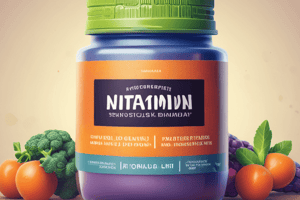Podcast
Questions and Answers
What is the recommended daily allowance of retinol for adult men?
What is the recommended daily allowance of retinol for adult men?
- 800-1000 µg/day (correct)
- 600 µg/day
- 4800 µg/day
- 2000 µg/day
Which of the following is a symptom of vitamin A toxicity?
Which of the following is a symptom of vitamin A toxicity?
- Keratomalacia
- Weight gain
- Night blindness
- Dermatitis (correct)
Which vitamin is primarily found in plant sources as carotene?
Which vitamin is primarily found in plant sources as carotene?
- Vitamin C
- Vitamin A (correct)
- Vitamin B6
- Vitamin K
What chemical term refers to all natural and synthetic forms of vitamin A?
What chemical term refers to all natural and synthetic forms of vitamin A?
What can prolonged deficiency of vitamin A lead to in terms of vision?
What can prolonged deficiency of vitamin A lead to in terms of vision?
What are the two broad classifications of vitamins?
What are the two broad classifications of vitamins?
Which vitamin is specifically classified as a B-complex vitamin?
Which vitamin is specifically classified as a B-complex vitamin?
What is the primary reason that higher organisms must obtain vitamins from their diet?
What is the primary reason that higher organisms must obtain vitamins from their diet?
Which statement about fat soluble vitamins is correct?
Which statement about fat soluble vitamins is correct?
Which vitamin was isolated from rice and led to the term 'vitamine'?
Which vitamin was isolated from rice and led to the term 'vitamine'?
Which of the following is a deficiency disease associated with vitamin C?
Which of the following is a deficiency disease associated with vitamin C?
What is the recommended daily allowance of vitamin C for adults?
What is the recommended daily allowance of vitamin C for adults?
What condition could result from the impairment in collagen synthesis due to vitamin C deficiency?
What condition could result from the impairment in collagen synthesis due to vitamin C deficiency?
Which of the following foods is NOT a source of vitamin C?
Which of the following foods is NOT a source of vitamin C?
What is the effect of oxidizing agents on vitamin C?
What is the effect of oxidizing agents on vitamin C?
Which chemical feature contributes to the acidic property of ascorbic acid (vitamin C)?
Which chemical feature contributes to the acidic property of ascorbic acid (vitamin C)?
How is vitamin C excreted from the body?
How is vitamin C excreted from the body?
What is a key role of Vitamin E in the body?
What is a key role of Vitamin E in the body?
Which vitamin is primarily involved in blood coagulation?
Which vitamin is primarily involved in blood coagulation?
What can cause a deficiency in Vitamin K?
What can cause a deficiency in Vitamin K?
How does Vitamin E protect against free radicals?
How does Vitamin E protect against free radicals?
What form of Vitamin K is found primarily in plant sources?
What form of Vitamin K is found primarily in plant sources?
Which of the following is a primary source of Vitamin K from animal sources?
Which of the following is a primary source of Vitamin K from animal sources?
What condition can result from hypervitaminosis K?
What condition can result from hypervitaminosis K?
Which of the following statements about Vitamin E is FALSE?
Which of the following statements about Vitamin E is FALSE?
Flashcards
Vitamins: What are they?
Vitamins: What are they?
Organic compounds essential for normal biological function, growth, and health, required in small amounts in the diet.
Fat-soluble vitamins
Fat-soluble vitamins
Vitamins that dissolve in fats, stored in liver and adipose tissue, not readily excreted in urine. Examples include vitamins A, D, E, and K.
Water-soluble vitamins
Water-soluble vitamins
Vitamins that dissolve in water, not stored significantly in the body, readily excreted in urine. Examples include vitamin C and B vitamins.
RDA (Recommended Daily Allowance)
RDA (Recommended Daily Allowance)
Signup and view all the flashcards
Vitamin deficiency
Vitamin deficiency
Signup and view all the flashcards
What is Vitamin A?
What is Vitamin A?
Signup and view all the flashcards
What is Beta-Carotene?
What is Beta-Carotene?
Signup and view all the flashcards
What is Retinal?
What is Retinal?
Signup and view all the flashcards
What is Night Blindness?
What is Night Blindness?
Signup and view all the flashcards
What is Xeropthalmia?
What is Xeropthalmia?
Signup and view all the flashcards
What is the function of Vitamin E in cell membranes?
What is the function of Vitamin E in cell membranes?
Signup and view all the flashcards
How does Vitamin E protect red blood cells?
How does Vitamin E protect red blood cells?
Signup and view all the flashcards
What is the role of Vitamin E in reproduction?
What is the role of Vitamin E in reproduction?
Signup and view all the flashcards
How does Vitamin E affect heme synthesis?
How does Vitamin E affect heme synthesis?
Signup and view all the flashcards
How does Vitamin E relate to vitamin A and carotenes?
How does Vitamin E relate to vitamin A and carotenes?
Signup and view all the flashcards
What is the role of Vitamin E in amino acid absorption?
What is the role of Vitamin E in amino acid absorption?
Signup and view all the flashcards
What is the role of Vitamin E in nucleic acid synthesis?
What is the role of Vitamin E in nucleic acid synthesis?
Signup and view all the flashcards
How does Vitamin E protect the liver?
How does Vitamin E protect the liver?
Signup and view all the flashcards
Isoprenoid Side Chains in Vitamin K
Isoprenoid Side Chains in Vitamin K
Signup and view all the flashcards
Vitamin C (Ascorbic Acid)
Vitamin C (Ascorbic Acid)
Signup and view all the flashcards
What is scurvy?
What is scurvy?
Signup and view all the flashcards
Vitamin C Absorption and Storage
Vitamin C Absorption and Storage
Signup and view all the flashcards
Vitamin C as an Antioxidant
Vitamin C as an Antioxidant
Signup and view all the flashcards
Vitamin C's Role in Collagen Synthesis
Vitamin C's Role in Collagen Synthesis
Signup and view all the flashcards
Vitamin C and Immune Function
Vitamin C and Immune Function
Signup and view all the flashcards
Study Notes
Vitamins
- Vitamins are organic compounds needed in small amounts for normal biological function and maintenance for optimum growth and health.
- E. coli synthesizes all vitamins
- Higher organisms obtain vitamins from their diet.
- Vitamins are required in small amounts, thus their degradation is relatively slow.
- Hopkins coined the term accessory factors for essential nutrients.
- Funk (1913) isolated an amine from rice and termed it vitamine (Greek for life).
- McCollum and Davis (1915) classified vitamins as fat-soluble and water-soluble.
Classification of Vitamins
- Vitamins are broadly classified as fat-soluble and water-soluble.
Fat-Soluble Vitamins
- Stored in the liver and adipose tissue.
- Not readily excreted in urine.
- Made of isoprene units.
- Examples include Vitamins A, D, E, and K
Water-Soluble Vitamins
- Not stored in large quantities.
- Readily excreted in urine.
- Heterogenous compounds.
- Examples include Vitamin C and B vitamins.
Vitamin A
- Fat-soluble vitamin.
- Found in animal products (e.g., retinol) and plant products (e.g., beta-carotene).
- RDA: 800-1,000 µg/day as retinol or 4,800-6,000 µg/day as beta-carotene.
- Plays a crucial role in vision, cell differentiation, and reproduction.
- Deficiency can lead to night blindness, xerophthalmia, and keratomalacia.
Vitamin D
- Fat-soluble vitamin.
- Produced in the skin through sun exposure. Also present in foods like fatty fish, fish liver oils, and egg yolk.
- RDA: 400 IU or 10 mg of cholecalciferol
- crucial for calcium and phosphorus absorption and bone health.
- Deficiency can lead to rickets in children and osteomalacia in adults.
Vitamin E
- Fat-soluble vitamin.
- Known as tocopherols/tocotrienols.
- Acts as an antioxidant, protecting cell membranes from damage.
- Found in vegetable oils, nuts, and seeds.
- Deficiency is rare in humans.
Vitamin K
- Fat-soluble vitamin.
- Found in vegetables and produced by intestinal bacteria.
- Crucial for blood clotting.
- Deficiency leads to increased blood clotting time.
Vitamin B Complex
- Water-soluble vitamins.
- Essential for various metabolic processes.
- Includes vitamins B1 through B12.
- Each vitamin has specific functions and sources.
Additional Notes
- Excessive consumption of vitamin A can be toxic (hypervitaminosis A).
- There are several coenzymes for vitamins, which are active forms involved in biochemical reactions.
- Good sources of vitamins are fruits, vegetables, and animal products.
- Recommended daily allowances (RDAs) vary by age and gender.
- Deficiencies in vitamins can lead to various health problems.
Studying That Suits You
Use AI to generate personalized quizzes and flashcards to suit your learning preferences.




